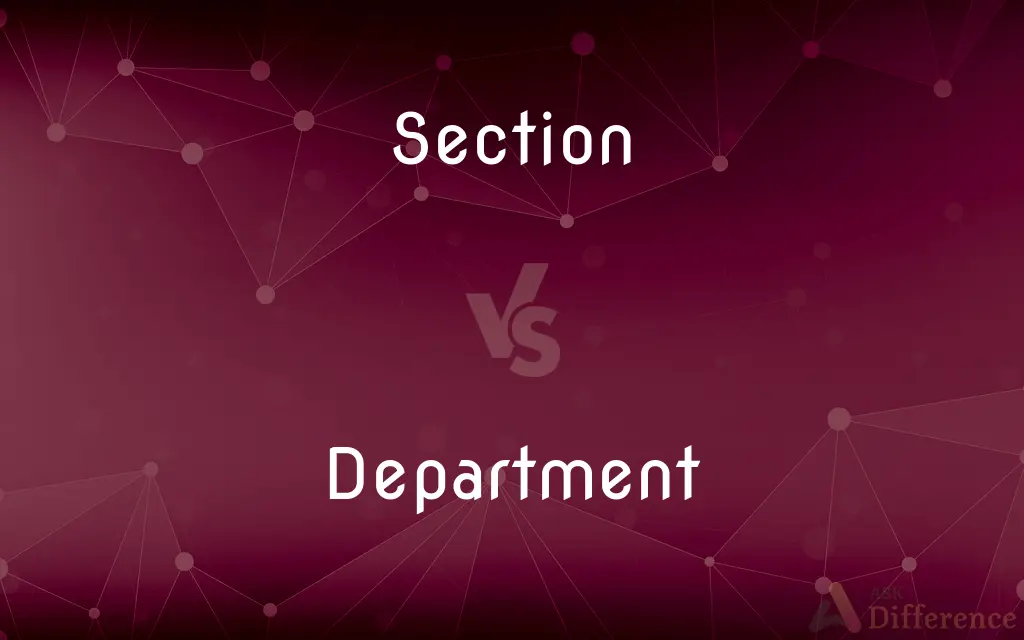Section vs. Department — What's the Difference?
Edited by Tayyaba Rehman — By Maham Liaqat — Updated on March 5, 2024
A section is a distinct part within a larger entity focusing on a specific task or topic, while a department is a broader administrative division handling a wider range of responsibilities within organizations.

Difference Between Section and Department
Table of Contents
ADVERTISEMENT
Key Differences
A section usually refers to a specialized unit within a department or organization, focusing on a particular aspect of the department's overall function. For instance, the customer service section within a department store specifically handles customer inquiries and issues. Whereas, a department is a major administrative division within a larger organization or government, encompassing several sections or units that deal with a broad area of activity, such as the Marketing Department of a company, which oversees various marketing-related activities including advertising, market research, and public relations.
Sections are generally smaller and more focused in their scope and responsibilities than departments. They concentrate on specific tasks or issues, providing specialized support or services. On the other hand, departments are larger and cover a wider range of activities, often encompassing multiple sections each dedicated to different aspects of the department's overall responsibilities.
The hierarchy within organizations typically places sections as components of departments. This means that sections operate under the umbrella of departments, contributing to the department's objectives with their specialized focus. Conversely, departments are structured to manage and oversee the broader strategic goals of the organization, coordinating the efforts of various sections under their domain.
Sections may have fewer employees and resources compared to departments, reflecting their focused scope of work. Whereas departments, being larger, generally have more employees and resources at their disposal to manage the diverse activities and functions they encompass.
The terminology and structure of sections versus departments can vary depending on the organization and its industry. In some contexts, the term "section" might be used interchangeably with "unit" or "team," each denoting a subdivision focusing on specific tasks. In contrast, the concept of a department is more universally recognized as a significant administrative segment within an organization, responsible for a broad set of objectives that are critical to the organization's overall mission.
ADVERTISEMENT
Comparison Chart
Scope
Narrow, focuses on a specific task or topic.
Broad, covers a wider range of responsibilities.
Size
Generally smaller, with fewer staff and resources.
Larger, with more staff and resources.
Hierarchy
Operates within departments.
Encompasses multiple sections or units.
Function
Provides specialized support or services.
Manages and oversees broader strategic goals.
Example
Customer service section in a department store.
Marketing Department in a company.
Organizational Level
Lower, closer to operational activities.
Higher, more strategic and administrative in nature.
Flexibility
More flexible due to smaller size and focused scope.
Less flexible due to larger size and broader scope.
Reporting
Reports to department heads or managers.
Reports to senior management or executive level.
Purpose
Enhances efficiency in specific tasks or processes.
Ensures overall effectiveness in a broad area.
Terminology Variation
May be referred to as "unit" or "team" in some contexts.
Generally recognized and used consistently.
Compare with Definitions
Section
A partitioned part of a structure or area.
The VIP section at the concert offered the best views.
Department
An academic division within a university or college.
He is studying in the department of mechanical engineering.
Section
A subsection of a department focusing on a specific function.
The finance department has a section dedicated to tax compliance.
Department
A field or sphere of activity or knowledge.
Ethics is an important department of philosophy.
Section
A group of people working together on a specific task.
Our research section is exploring new sustainability practices.
Department
A governmental division conducting specific duties.
The department of health issued new guidelines.
Section
A distinct area within a larger space or document.
Please refer to section 4.2 for more details.
Department
A major administrative division of a business or organization.
She works in the human resources department.
Section
A segment of a society or community with shared interests.
The youth section of the library is very popular.
Department
A division of a large store or company.
The home goods department is on the third floor.
Section
One of several components; a piece.
Department
A division of a large organization such as a government, university, or business, dealing with a specific area of activity
The council's finance department
Section
A specialized division of a large organization;
You'll find it in the hardware department
She got a job in the historical section of the Treasury
Department
A principal administrative division of a government
The department of public works.
Section
A segment of a citrus fruit;
He ate a section of the orange
Department
A division of a business specializing in a particular product or service
The personnel department.
Section
Divide into segments;
Segment an orange
Segment a compound word
Department
A part, portion, or subdivision.
Department
A specialized division of a large organization;
You'll find it in the hardware department
She got a job in the historical section of the Treasury
Common Curiosities
What is the main difference between a section and a department?
The main difference lies in their scope and size; sections have a narrower focus and are smaller, while departments cover broader areas and are larger.
Is it possible for a section to become a department?
Yes, a section can become a department if it grows in size and scope, necessitating a broader administrative structure.
Can a department exist without sections?
Yes, a department can exist without sections if its functions are broad but not divided into specialized subareas.
How does the hierarchy typically work between sections and departments?
Sections typically operate within departments, focusing on specific tasks that contribute to the department's broader objectives.
How do staffing levels differ between sections and departments?
Departments generally have more staff and resources due to their broader scope, while sections are smaller and more focused.
Are there any industries where sections are more prevalent than departments?
Sections are common in industries requiring specialized focus within larger entities, such as healthcare, academia, and government.
How does the purpose of sections and departments differ?
Sections aim to enhance efficiency in specific tasks, while departments ensure overall effectiveness and strategic alignment in a broader area.
Are sections and departments interchangeable terms?
No, they are not interchangeable; sections refer to smaller, specialized units within departments, which are larger administrative divisions.
Can an individual work in both a section and its department?
Yes, individuals may work within a section and contribute to the broader departmental goals, depending on their role and the organization's structure.
Do departments directly interact with the executive level of an organization?
Yes, departments typically report to and interact directly with the senior management or executive level of an organization.
Can a department function effectively without sections?
While a department can function without sections, having specialized units can enhance efficiency and effectiveness in achieving specific goals.
How do sections contribute to an organization's success?
Sections enhance efficiency by focusing on specific tasks or processes, which contributes to the overall success of the organization.
Can the structure of sections and departments vary between organizations?
Yes, the structure and terminology can vary significantly depending on the organization's size, industry, and specific needs.
How does communication flow between sections and departments?
Communication flows from sections to department heads or managers, and then up to higher management, facilitating coordination and strategic planning.
Do sections and departments have different levels of flexibility?
Yes, sections tend to be more flexible due to their smaller size and focused scope, while departments have less flexibility due to their larger size and broader responsibilities.
Share Your Discovery

Previous Comparison
Loft vs. Condo
Next Comparison
Composer vs. ConductorAuthor Spotlight
Written by
Maham LiaqatEdited by
Tayyaba RehmanTayyaba Rehman is a distinguished writer, currently serving as a primary contributor to askdifference.com. As a researcher in semantics and etymology, Tayyaba's passion for the complexity of languages and their distinctions has found a perfect home on the platform. Tayyaba delves into the intricacies of language, distinguishing between commonly confused words and phrases, thereby providing clarity for readers worldwide.















































